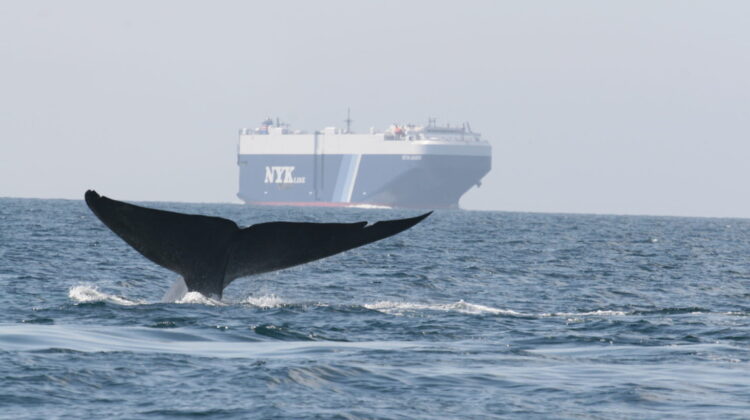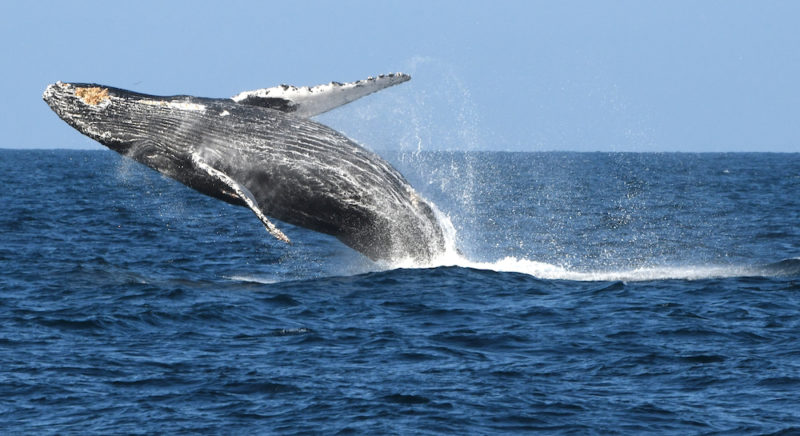
Sixteen global shipping companies slowed cargo ships off California coast to protect blue whales and blue skies
CALIFORNIA : The partners in an initiative to cut air pollution and protect endangered whales announced results from the 2020 program and recognized the shipping companies that successfully participated, reducing speeds to 10 knots or less in the San Francisco Bay Area and the Southern California region. The program’s new Southern California region extends from Point Arguello (in Santa Barbara County) to waters near Dana Point (by the Ports of Los Angeles and Long Beach).
The voluntary incentive program, called “Protecting Blue Whales and Blue Skies,” ran May 15, 2020 through November 15, 2020.
Shipping companies receive recognition and financial awards based on the percent of distance traveled by their vessels through the Vessel Speed Reduction (VSR) zones at 10 knots or less and with an average speed of 12 knots or less. The 10-knot target complements the National Oceanic and Atmospheric Administration’s (NOAA) requests for all vessels (300 gross tons or larger) to slow down during the months of peak endangered blue, humpback, and fin whale abundance to protect these whales from deadly ship strikes.

Ship strikes are a major threat to whales globally and to the recovery of endangered blue, fin, and humpback whales in California waters. Reducing the risk of ship strikes is a major priority of NOAA’s, including NOAA’s West Coast national marine sanctuaries. Observed and documented deaths totaled 49 endangered whales from 2007-2020, and likely represent only a small fraction of the total number of ship strikes taking place annually.
The timing of the program also coincides with the season when ground-level ozone (smog) concentrations are typically high. The 10-knot target allows ships to travel at an efficient operating load using less fuel and producing less pollution. Ocean-going vessels transiting the California coast generate nitrogen oxides (NOx, a precursor to smog), sulfur oxides (SOx), particle pollution, and greenhouse gases. These vessels account for more than 200 tons of NOx per day emitted off the coast of California, which affects ozone levels onshore in many regions of the state. The areas of greater Los Angeles (including Ventura County), Santa Barbara, and the San Francisco Bay do not meet the state and/or federal air quality standards for ozone.
The program is a collaborative effort by the following agencies and organizations:
· Santa Barbara County Air Pollution Control District
· Ventura County Air Pollution Control District
· Bay Area Air Quality Management District
· National Marine Sanctuaries: Channel Islands, Cordell Bank, Greater Farallones
· The Volgenau Foundation
· California Marine Sanctuary Foundation
· Greater Farallones Association
· National Marine Sanctuary Foundation
· Environmental Defense Center
· Point Blue Conservation Science
· Starcrest Consulting
· Scripps Institution of Oceanography
The program partners established three award tiers to recognize participating companies based on the percent of distance their fleet traveled through the VSR zones at speeds of 10 knots or less. The three award tiers are Sapphire (75-100% of fleet total distance in VSR zones traveled at 10 knots or less), Gold (50-74%), and Blue Sky (25-49%). Automatic Identification System (AIS) transponders on each ship transmit the ship’s speed, heading, and location; AIS data was analyzed for each fleet and the company’s performance was classified by tier. Companies that performed at Gold or Sapphire level were awarded a financial incentive.
MSC, Hapag-Lloyd, Yang Ming, and MOL ACE notably achieved the Sapphire tier in the large company category (greater than 30 transits) by slowing down more than 800 transits, combined. Swire Shipping achieved the Sapphire tier in the small company category (less than 30 transits). For their outstanding commitment, all five of these companies earned the Protecting Blue Whales and Blue Skies Whale Tail award.
Seven companies – COSCO Shipping Lines, Evergreen, GALI, “K” Line, Maersk, Wallenius Wilhelmsen, and Swire Shipping – generously declined their financial incentive payment. Those funds will be used for additional public recognition efforts and reinvested in the 2021 program.
The VSR incentive program has expanded in scope and environmental benefits each year, including 2020, which marked the sixth year.

The 2021 program started on May 15, 2021. For more information, visit www.ourair.org/air-pollution-marine-shipping.
Program partners comment:
“As air pollution from on-road vehicles and stationary sources is reduced with new technologies, the emissions from ocean-going vessels become even more impactful to air quality in Ventura County. This voluntary, incentive-based program is an effective way to reduce emissions in the short term until new technologies are implemented in the international shipping fleet. We are grateful for the continued participation and increased cooperation of the shipping companies and commend them for their environmental responsibility.” Dr. Laki Tisopulos, Air Pollution Control Officer, Ventura County Air Pollution Control District
Dr. Laki Tisopulos, Air Pollution Control Officer,
Ventura County Air Pollution Control District
“We applaud the participating shipping companies, many of which have returned to this program year after year. Their voluntary efforts to slow down their vessels have translated to significant benefits for air quality and endangered whales. This program continues to show what great things can happen when local, state, national, and international organizations collaborate.”
Aeron Arlin Genet, Air Pollution Control Officer
Santa Barbara County Air Pollution Control District
“The continued success of the Vessel Speed Reduction Program in lowering air pollution and protecting migrating whales is something our partnership can be proud of. Significant benefits for public health and the environment can be accomplished when public, private, and non-profit organizations collaborate over the long term.”
Jack Broadbent, Executive Officer
Bay Area Air Quality Management District
“The National Marine Sanctuaries Act guides us to create models of, and incentives for, ways to conserve and manage, including innovative management techniques. This innovative incentive-based vessel speed reduction program, in collaboration with county air management districts, the shipping industry, other agencies, and NGOs, serves as a model for enhancing ocean and human health while promoting a sustainable, blue economy.”
Chris Mobley, Superintendent
Channel Islands National Marine Sanctuary
“The survival of these endangered whales is up to all of us. The success of this program hinges on the shipping industry’s willingness to advance whale conservation and promote cleaner air, while conducting commerce, in partnership with agencies and nonprofits. By working together, we can ensure blue, fin, and humpback whales continue to live on this planet.”
Maria Brown, Superintendent
Greater Farallones National Marine Sanctuary (also on behalf of Cordell Bank National Marine Sanctuary)
“What started as an innovative pilot project that brought together environmental groups, the shipping industry, as well as federal and local governments in an effort to protect endangered whales and improve air quality has proven incredibly effective at accomplishing both goals. The Environmental Defense Center will continue our work to ensure these efforts are rewarded by legislation that would provide this vital program with the resources it needs to thrive long into the future.”
Kristen Hislop, Marine Conservation Program Director
The Environmental Defense Center
“We are proud to be a part of this partnership that helps improve air quality and protect marine species, particularly endangered whales. Each year, the increasing participation of shipping companies contributes to the goal of a sustainable outcome. We especially commend those companies that declined their incentives, which truly shows their support of conservation along the coast. We hope that many more will follow their commitment to significantly improve ocean and human health for future generations.”
Source : gCaptain
